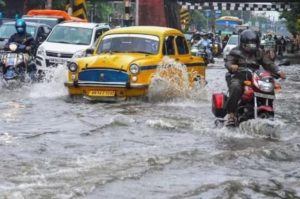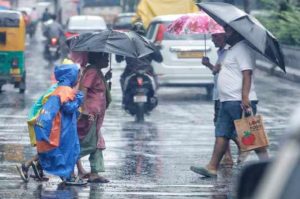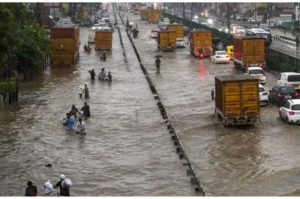Kolkata Flooded After Torrential Rains — A spell of intense monsoon rain submerged large parts of Kolkata on Monday evening, causing massive traffic snarls, disrupted train schedules, and temporary suspension of Metro services in several locations. The city, already battling drainage issues and aging infrastructure, found itself again struggling against waterlogged roads, paralyzed commutes, and panicked citizens trying to get home amid rising water levels.

Rainfall Snapshot and Meteorological Background
The Indian Meteorological Department (IMD) reported that a deep low-pressure system formed over the Gangetic plains intensified rainfall in south Bengal. As a result, many Kolkata neighborhoods recorded over 100 mm of rainfall within just a few hours, a spike that the city’s century-old drainage system could not manage.
Reference: India Meteorological Department (IMD)
Meteorologists noted that such short-duration high-intensity rainfall is becoming more common in eastern India due to shifts in atmospheric dynamics fueled by urban heat and climate variability.


Kolkata Flooded After Torrential Rains: Areas Worst Hit
Major localities that bore the brunt of the downpour include:
- Ballygunge, Behala, and Chetla
- EM Bypass, from Ruby to Science City
- Ultadanga, Salt Lake Sector I & III
- Howrah Maidan, Lake Gardens, and parts of Park Circus
By 6:30 p.m., streets in these zones were under water, and many residents were stranded at bus stands, Metro stations, and auto terminals.
Public Transport Disruptions
Kolkata Metro experienced a delay in north-south corridor services due to water entering the signaling room near Tollygunge. Services were resumed after nearly 40 minutes of emergency repairs.
Local trains were also affected. On the Sealdah–Main line, waterlogging on tracks near Dum Dum and Bidhannagar Road disrupted suburban train timings. Several passengers were seen wading through knee-deep water to reach platforms.
Private bus operators curtailed services by 50% in the evening, citing low visibility, damaged roads, and submerged intersections.


Civic Response: KMC’s Emergency Deployment
The Kolkata Municipal Corporation (KMC) activated all 73 pumping stations across the city. Portable pumps were deployed in localities like Jadavpur, Kalighat, and Kidderpore. Despite that, the heavy intensity of the rain over a short span overwhelmed drain capacity.
Mayor Firhad Hakim stated that while primary pumps were operational, water receded slowly due to backflow from the Hooghly and poor slope in certain parts of South Kolkata.
Reference: KMC Drainage Services
Civic workers were also seen removing plastic waste clogging inlets, a recurring issue that exacerbates waterlogging.
Safety Concerns and Power Disruptions
In areas like Behala, Garden Reach, and Tiljala, electricity supply was cut off as a precaution to avoid electrocution. The CESC confirmed power was restored only after water receded to safe levels. Several shops, especially in ground-floor markets, reported short circuits and water damage to stock.
Citizens were warned not to walk barefoot in flooded streets due to open manholes, damaged cables, and waterborne bacteria.
Impact on Schools and Workplaces
Many schools remained closed on Tuesday following Monday’s late-evening chaos. Students in EM Bypass and Tollygunge areas were particularly affected, with several guardians expressing concern over poor drainage outside school gates.
IT companies in Salt Lake’s Sector V operated on hybrid mode after employees struggled with transport. Offices in Dalhousie and Park Street saw a sharp drop in attendance as both taxis and app-based services were overbooked.
Broader Infrastructure Concerns
Urban planning experts have repeatedly flagged Kolkata’s outdated drainage blueprint. The city’s primary sewer lines were laid during the British era and are no longer capable of handling the increased runoff from new concrete construction and shrinking open grounds.
Civic activists are calling for:
- Widening of outfall channels
- Rainwater harvesting at block level
- Real-time water level monitoring
- Better enforcement of plastic waste rules
Reference: National Institute of Urban Affairs – Smart City Water Resilience Guidelines
Looking Ahead: Forecast & Civic Planning
The IMD has forecast moderate rain over the next 48 hours with a possibility of thunderstorms. In response, the KMC has kept field teams on alert and maintained mobile drainage vans across 144 wards.
The Kolkata Police is also continuing to monitor water levels in accident-prone zones like Amherst Street, Rashbehari, and Beliaghata, issuing regular alerts via X (formerly Twitter).
Meanwhile, work continues on major projects to modernize the city’s drainage infrastructure, including the Behala–Taratala sewer upgradation and the KMC–JICA Stormwater Master Plan.
Final Word
Kolkata’s brief but powerful deluge once again exposes the urgent need for resilient infrastructure, proactive civic planning, and strong environmental regulation. As monsoons grow more erratic, the city cannot afford to rely on short-term relief alone. Sustainable urban water management is not a luxury anymore—it’s a necessity.
Also read: Home | Channel 6 Network – Latest News, Breaking Updates: Politics, Business, Tech & More

